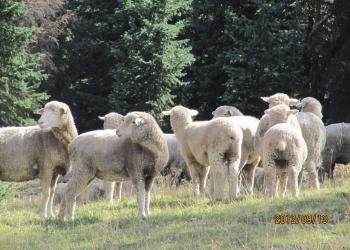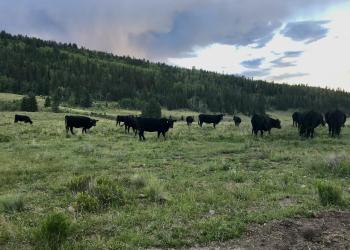Rangeland and Grazing
Livestock grazing has been permitted on Forest Service lands since 1934 and is part of the Forest Service multiple use mission. These lands provide a workplace for ranchers and vast open spaces for recreation use. Grazing supports the local economy and the historic ranching heritage of Colorado.

Prior to the establishment of the San Juan Forest Reserve and the Cochetopa Forest Reserve in 1905, and the resultant Rio Grande National Forest in 1908 (combination of portions of the San Juan and Cochetopa Forest Reserves), unregulated livestock grazing had been occurring in these mountains since the late 1800’s. Numbers of livestock (without management) in those days were the highest in history and considerable damage was done to the rangelands. Sheep numbers then were in the hundreds of thousands and cattle numbers were much higher than they are now. Livestock grazing was allowed on the Forest Reserves and consequently the Rio Grande National Forest in 1908. Much work began to get the numbers, seasons, and management of those livestock under control. The Taylor Grazing of 1934, established grazing allotments and provided for the regulation of grazing on the public lands to improve rangeland conditions and regulate their use. This was the advent of rangeland management in earnest. Rangeland Management has evolved tremendously since the early years and consequently the current science-based approach is sustainable, providing many benefits.
Today, livestock grazing is still a part of the Forest Service multiple use mission. The Rio Grande National Forest uses grazing as a land management tool across 581,000 acres. The Rio Grande has 83 active cattle and sheep allotments across three ranger districts, 75 permittees, authorizing 75,685 animal-unit-months and 72,024 head months (2021 Annual Grazing Statistical Report). Domestic livestock grazing contributes to the stability of the surrounding ranching community and its values are recognized as a part of the heritage, for contributions to food and fiber, and for maintenance of open space.
Local ranchers hold grazing permits and pay to graze their livestock on public lands. Ranchers are permitted to graze in set areas called allotments. Each allotment is divided into pastures that the cattle are rotated through during summer months to ensure proper utilization. The Taylor Grazing Act of 1934 predates the Wilderness Act of 1964. Livestock grazing is permitted within Wilderness areas.
- Maintains a balanced and diverse ecosystem
- Provides community open spaces
- Reduces fuels for fires
- Increases native plant diversity
- Provide important water sources for wildlife
- Control pets when you see cattle and wildlife
- Please leave gates as you find them to keep cattle in the proper pasture
- As you approach talk loudly and make noise so cattle or horses are not startled
- All users yield to cattle and horses on trails
Monitoring
Range conditions are monitored in key areas on all Forest allotments. The information gathered identifies use patterns, species composition, ground cover, and species frequency. Annual monitoring data show that livestock grazing is ecologically feasible at current levels. Grazing management applies adaptive management principles that allow range managers to modify stocking levels relatively quickly in response to variations in forage production, water availability, and precipitation patterns. These principles have been applied in the past to respond to extended drought conditions and wildfires.
Resources
Sheep

Sheep historically were grazed across the Rio Grande National Forest. There are still some sheep allotments on the forest that are carefully managed to prevent contact with wild bighorn sheep. Photo: Sheep grazing on the Bancos Alazon S&G Allotment on Conejos Peak RD.
Cows

You may see cows grazing when you visit the forest. Ranchers lease allotments and graze their cattle on the forest during the summer. Cows are moved between areas to meet ecological goals. Our rangeland managers help look after this natural and renewable resource.



